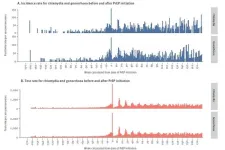(Press-News.org) In the largest and one of the most ambitious Hubble Space Telescope programs ever executed, a team of scientists and engineers collected information on almost 500 stars over a three-year period. This effort offers new insights into the stars' formation, evolution, and impact on their surroundings.
This comprehensive survey, called ULLYSES (Ultraviolet Legacy Library of Young Stars as Essential Standards), was completed in December 2023, and provides a rich spectroscopic dataset obtained in ultraviolet light that astronomers will be mining for decades to come. Because ultraviolet light can only be observed from space, Hubble is the only active telescope that can accomplish this research.
"I believe the ULLYSES project will be transformative, impacting overall astrophysics – from exoplanets, to the effects of massive stars on galaxy evolution, to understanding the earliest stages of the evolving universe," said Julia Roman-Duval, Implementation Team Lead for ULLYSES at the Space Telescope Science Institute (STScI) in Baltimore, Maryland. "Aside from the specific goals of the program, the stellar data can also be used in fields of astrophysics in ways we can’t yet imagine."
The ULLYSES team studied 220 stars, then combined those observations with information from the Hubble archive on 275 additional stars. The program also included data from some of the world's largest, most powerful ground-based telescopes and X-ray space telescopes. The ULLYSES dataset is made up of stellar spectra, which carry information about each star's temperature, chemical composition, and rotation.
One type of stars studied under ULLYSES is super-hot, massive, blue stars. They are a million times brighter than the Sun and glow fiercely in ultraviolet light that can easily be detected by Hubble. Their spectra include key diagnostics of the speed of their powerful winds. The winds drive galaxy evolution and seed galaxies with the elements needed for life. Those elements are cooked up inside the stars' nuclear fusion ovens and then injected into space as a star dies. ULLYSES targeted blue stars in nearby galaxies that are deficient in elements heavier than helium and hydrogen. This type of galaxy was common in the very early universe. "ULLYSES observations are a stepping stone to understanding those first stars and their winds in the universe, and how they impact the evolution of their young host galaxy," said Roman-Duval.
The other star category in the ULLYSES program is young stars less massive than our Sun. Though cooler and redder than our Sun, in their formative years they unleash a torrent of high-energy radiation, including blasts of ultraviolet light and X-rays. Because they are still growing, they are gathering material from their surrounding planet-forming disks of dust and gas. The Hubble spectra include key diagnostics of the process by which they acquire their mass, including how much energy this process releases into the surrounding planet-forming disk and nearby environment. The blistering ultraviolet light from young stars affects the evolution of these disks as they form planets, as well as the chances of habitability for newborn planets. The target stars are located in nearby star-forming regions in our Milky Way galaxy.
The ULLYSES concept was designed by a committee of experts with the goal of using Hubble to provide a legacy set of stellar observations. "ULLYSES was originally conceived as an observing program utilizing Hubble's sensitive spectrographs. However, the program was tremendously enhanced by community-led coordinated and ancillary observations with other ground- and space-based observatories," said Roman-Duval. "Such broad coverage allows astronomers to investigate the lives of stars in unprecedented detail and paint a more comprehensive picture of the properties of these stars and how they impact their environment."
To that end, STScI hosted a ULLYSES workshop March 11–14 to celebrate the beginning of a new era of research on young stars. The goal was to allow members of the astronomical community to collaborate on the data, so that they could gain momentum in the ongoing analyses, or kickstart new ideas for analysis. The workshop was one important step in exploiting this legacy spectral library to its fullest potential, fulfilling the promise of ULLYSES.
The Hubble Space Telescope has been operating for over three decades and continues to make ground-breaking discoveries that shape our fundamental understanding of the universe. Hubble is a project of international cooperation between NASA and ESA (European Space Agency). NASA's Goddard Space Flight Center in Greenbelt, Maryland, manages the telescope and mission operations. Lockheed Martin Space, based in Denver, Colorado, also supports mission operations at Goddard. The Space Telescope Science Institute in Baltimore, Maryland, which is operated by the Association of Universities for Research in Astronomy, conducts Hubble science operations for NASA.
Media Contacts:
Claire Andreoli
NASA's Goddard Space Flight Center, Greenbelt, MD
claire.andreoli@nasa.gov
Ann Jenkins / Ray Villard
Space Telescope Science Institute, Baltimore, MD
Science Contact:
Julia Roman-Duval
Space Telescope Science Institute, Baltimore, MD
END
Three-year study of young stars with NASA’s Hubble enters new chapter
2024-03-28
ELSE PRESS RELEASES FROM THIS DATE:
North Carolina takes the lead in PFAs research with Collaboratory’s $3 million investment to expand the state’s research capacity
2024-03-28
WILMINGTON, N.C. (March 27, 2024) – The North Carolina Collaboratory – an organization dedicated to advancing scientific research for policymaking within North Carolina – today announced its partnership with Thermo Fisher Scientific to advance the State’s per- and polyfluoroalkyl substances (PFAS) research capabilities. Supported by critical appropriations from the North Carolina General Assembly (NCGA), the Collaboratory purchased five state-of-the-art mass spectrometers that continue to position North Carolina at the forefront of academic PFAS research nationally. This new partnership ...
Is it the school, or the students?
2024-03-28
Are schools that feature strong test scores highly effective, or do they mostly enroll students who are already well-prepared for success? A study co-authored by MIT scholars concludes that widely disseminated school quality ratings reflect the preparation and family background of their students as much or more than a school’s contribution to learning gains.
Indeed, the study finds that many schools that receive relatively low ratings perform better than these ratings would imply. Conventional ...
Exploring the relationship between HIV pre-exposure prophylaxis and the incidence of chlamydia, gonorrhea and syphilis – findings from Denmark
2024-03-28
In their research article published in Eurosurveillance, von Schreeb et al. challenge existing assumptions regarding the relationship between the use of HIV pre-exposure prophylaxis (PrEP) and the incidence of bacterial sexually transmitted infections (STI). According to the concept of sexual risk compensation, the start of PrEP treatment – a drug regimen which effectively prevents acquiring HIV – is associated with rises in STI as people feel protected against HIV while using it. However, von Schreeb et al. argue that available ...
Music: Song lyrics have become simpler and more repetitive since 1980
2024-03-28
We have been alerted to a potential error in some of the coding used by the authors in their analyses and are looking into this as a matter of urgency. The authors are confident that the main findings of the paper will remain unaltered, however some aspects may be affected and we have removed two sentences from the press release to reflect this. We will provide an update if there are further developments. We apologise for any inconvenience caused.
The lyrics of English-language songs have become simpler and more repetitive over the past 40 years, according to a study published in Scientific Reports.
Eva Zangerle and ...
Environment: More than half of Colorado River’s water used to irrigate crops
2024-03-28
Irrigation for agriculture uses more than half of the Colorado River’s total annual water flow, reports a paper published in Communications Earth & Environment. This finding is part of a new comprehensive assessment of how the Colorado River’s water is consumed — including both human usage and natural losses — and provides a more complete understanding of how the river’s water is used along its over 2,300 km (almost 1,500-mile) length.
The Colorado River flows through the southwestern United States (including the Grand Canyon) and northwestern Mexico whilst supplying water to more than 40 million people and more than 2 million ...
When inequality is more than “skin-deep”: Social status leaves traces in the epigenome of spotted hyenas in Tanzania
2024-03-28
A research consortium led by scientists from the Leibniz Institute for Zoo and Wildlife Research (Leibniz-IZW) provide evidence that social behaviour and social status are reflected at the molecular level of gene activation (epigenome) in juvenile and adult free-ranging spotted hyenas. They analysed non-invasively collected gut epithelium samples from both high-ranking and low-ranking female hyenas and showed that rank differences were associated with epigenetic signatures of social inequality, i.e., the pattern of activation or switching off of genes that regulate important physiological processes such as energy conversion and immune response ...
Study explores the future of at-home cancer treatment
2024-03-28
LOS ANGELES — A clinical trial from Keck Medicine of USC will test the feasibility of treating non-small cell lung cancer with immunotherapy provided at home.
Immunotherapy, medicines that use the body’s immune system to eliminate or control cancer cells, are effective for many cancer patients, but are currently only administered intravenously (into the vein) in a doctor’s office or hospital.
The study will examine if a new formulation of atezolizumab, an immunotherapy approved for treating certain types of non-small cell lung cancer, can instead be safely and effectively ...
First performance standards published to measure the effectiveness of lifestyle medicine treatments
2024-03-28
An expert panel has published the first performance measures to identify remission and evaluate the effectiveness of lifestyle medicine treatments, which will allow more objective comparisons between lifestyle behavior interventions and other non-lifestyle treatments.
The performance measures are significant because, as interest in the field of lifestyle medicine has grown, it became clear that the lack of standards to document remission or long-term progress following lifestyle medicine treatment was a barrier to the widespread integration of the ...
To keep volunteers, connect them
2024-03-28
At a time when America needs volunteers more than ever, to tackle social problems from homelessness to disaster recovery, fewer people have been volunteering.
The number of volunteers for nonprofit and community-based organizations declined recently for the first time in decades, from 30% of the population in 2019 to 23% in 2021. That’s according to AmeriCorps and the U.S Census Bureau, which have tracked rates of volunteerism since 2002.
New research from Yifan Yu, assistant professor of ...
Suppressing boredom at work hurts future productivity, study shows
2024-03-28
Boredom is more common at work than in any other setting, studies show, and employees are bored at work for more than 10 hours per week on average.
Even astronauts and police officers get bored on the job. No occupation is immune.
Boredom serves an important purpose — it signals the need to stop an action and find an alternative project. But boredom becomes problematic when it’s ignored.
New research from the University of Notre Dame shows that trying to stifle boredom prolongs its effects and that alternating boring and meaningful tasks helps to prevent the effects of one boring task from ...




